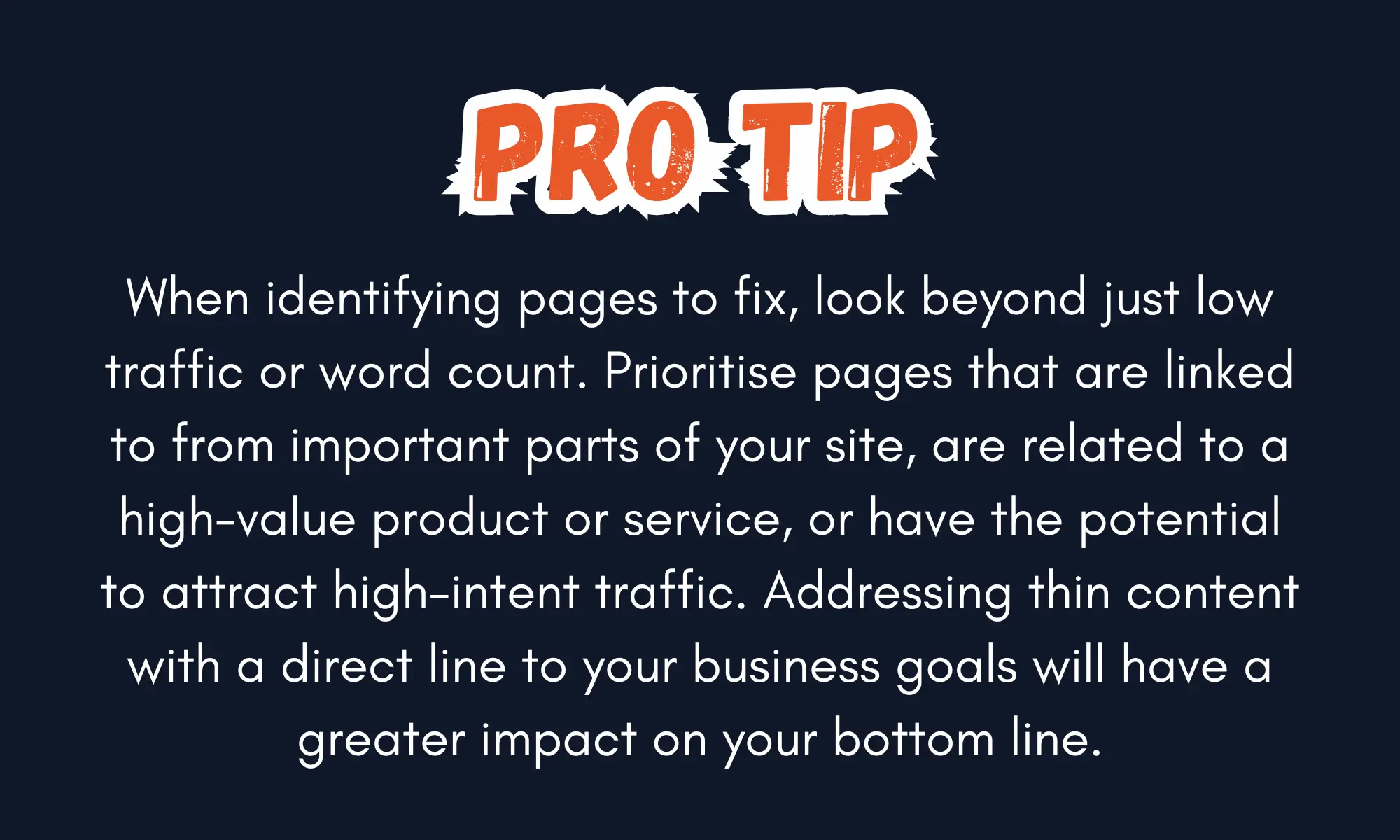Is Thin Content Killing Your SEO? The 3-Step Plan to Fix It

You’ve been diligently adding pages to your website, but your search traffic isn’t growing. In fact, it might be shrinking. The problem isn’t a lack of content; it's the quality of it. In the eyes of a search engine, not all pages are created equal. A common and serious issue is thin content, which refers to pages that offer little to no unique value to the user.
Thin content isn't just a nuisance; it's a major signal of low quality that can drag down your entire website's authority. Google's algorithms are designed to prioritise comprehensive, helpful information, and pages that fall short of this standard can lead to lower rankings, wasted crawl budget, and ultimately, lost business.
This article will explain what thin content is, why it's so dangerous, and provide a strategic, three-step plan to identify and fix it - a process that’s essential for any serious SEO strategy.

The Problem: Why Thin Content Is a Serious SEO Liability
Thin content is any page that doesn't provide significant value to a user. This can take many forms:
- Short, Unoriginal Articles: Blog posts that are only a few hundred words long and offer no unique insight.
- Auto-Generated Text: Product descriptions or category pages that are automatically generated and lack human-written, descriptive content.
- Duplicate Content: Pages that are identical or nearly identical to other pages on your site or elsewhere on the web.
- Doorway Pages: Pages created solely for search engines, with no value for real users.
The dangers of thin content are significant and far-reaching. It’s not just about a single page; it’s about a site-wide perception of quality.
- It Devalues Your Entire Site: Google views thin content as a sign of a low-quality website. A large quantity of these pages can negatively impact your overall domain authority, making it harder for your good pages to rank.
- It Wastes Crawl Budget: Every website has a limited crawl budget - the number of pages Googlebot can and wants to crawl in a given time. When Google spends its limited time crawling and indexing hundreds of low-value pages, it's wasting resources that could be used to discover your high-value content.
- It Leads to Poor User Engagement: When a user lands on a thin page, they quickly realise there’s no value and hit the back button. This leads to a high bounce rate, which is another negative signal to Google that your content isn’t meeting user expectations.
.webp)
The Solution: A Strategic Three-Step Plan
Fixing thin content isn't about a mindless deletion spree. It requires a nuanced, data-driven approach to ensure you're not accidentally removing pages that provide some value or have existing links.
Step 1: Identify Your Thin Content
You can't fix what you can't find. The first step is to get a clear picture of your website’s problem areas.
- Use Google Search Console: Look for pages with low impressions, low click-through rates, or a high number of impressions but no clicks. These are often indicators of pages that Google sees but doesn't consider valuable enough to rank.
- Run a Site Audit: Use a professional tool to scan your website for pages with a low word count, low traffic, and duplicate content issues.
- Manual Review: Conduct a manual review of your older blog posts, product pages, and category descriptions to identify content that is outdated, unoriginal, or overly brief.
Step 2: Strategically Categorise Your Thin Content
Once you have a list of your thin pages, you need to decide on a course of action. Every page falls into one of three strategic categories:
- Upgrade: For pages that have a clear purpose and some potential, the best solution is to significantly expand and improve the content. Turn a short blog post into a comprehensive guide, or add detailed, unique descriptions to auto-generated product pages. The goal is to make these pages genuinely valuable and authoritative.
- Consolidate: If you have multiple pages that cover a similar or related topic, consolidate them. Combine them into a single, comprehensive page that provides more value than the sum of its parts. Once you have the new, authoritative page, use 301 redirects to point the old URLs to the new one. This preserves any existing link equity and signals to Google that the content has been moved, not just deleted.
- Eliminate/De-index: For content that is truly low-value with no potential for improvement - such as old, outdated event pages or test pages - the best action is to eliminate it.
You have two options:
- Delete and 404: Remove the page entirely. This is often the best option for completely useless pages.
- Use a noindex tag: If you need to keep the page for internal reasons but don't want it appearing in Google's index, you can use a noindex tag in the page's HTML. This tells Google to stop crawling and indexing the page, saving your crawl budget for more important content.
.webp)
The "Appear Online" Perspective: Beyond the Checklist
Fixing thin content is a strategic task that requires a technical understanding of SEO, not just a checklist. Doing this incorrectly can lead to unintended consequences, such as accidentally de-indexing a valuable page or creating broken links. The process is particularly complex for large e-commerce or enterprise websites with thousands of URLs.
At Appear Online, we specialise in a data-driven approach to technical SEO. We don't just identify thin content; we perform a full-scale audit and create a strategic plan tailored to your website's unique needs. We can help you navigate the process of upgrading, consolidating, or de-indexing your pages to ensure that every URL on your site is contributing positively to your SEO performance.
Conclusion: A Foundation for Growth
In the modern digital landscape, quality triumphs over quantity. Having fewer, more authoritative pages is always better than having a large number of low-value pages. Addressing thin content is a fundamental step toward building a high-quality website that Google trusts and rewards. It's a crucial part of a comprehensive SEO strategy that removes the dead weight and allows your truly valuable content to shine.
If you're ready to audit your website and build a cleaner, more powerful online presence, contact us today to discuss how we can help.
.webp)
References:
https://developers.google.com/search/docs/crawling-indexing/block-indexing
https://developers.google.com/search/docs/crawling-indexing/googlebot
https://www.google.com/intl/en_us/search/howsearchworks/how-search-works/ranking-results
.avif)

.webp)






